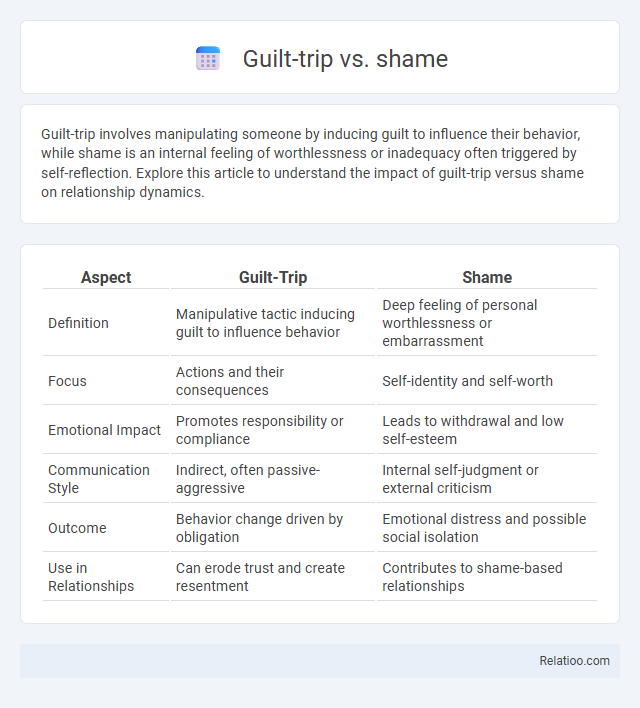Guilt-trip involves manipulating someone by inducing guilt to influence their behavior, while shame is an internal feeling of worthlessness or inadequacy often triggered by self-reflection. Explore this article to understand the impact of guilt-trip versus shame on relationship dynamics.
Table of Comparison
| Aspect | Guilt-Trip | Shame |
|---|---|---|
| Definition | Manipulative tactic inducing guilt to influence behavior | Deep feeling of personal worthlessness or embarrassment |
| Focus | Actions and their consequences | Self-identity and self-worth |
| Emotional Impact | Promotes responsibility or compliance | Leads to withdrawal and low self-esteem |
| Communication Style | Indirect, often passive-aggressive | Internal self-judgment or external criticism |
| Outcome | Behavior change driven by obligation | Emotional distress and possible social isolation |
| Use in Relationships | Can erode trust and create resentment | Contributes to shame-based relationships |
Understanding Guilt-Trip and Shame: Key Differences
Guilt-trip involves inducing feelings of guilt in someone to influence their behavior, often through manipulation, whereas shame is a deeper, internal emotion reflecting a negative self-assessment and feelings of unworthiness. Understanding the distinction between guilt-trip and shame is crucial, as guilt revolves around specific actions and can motivate positive change, while shame impacts identity and may lead to emotional withdrawal. Recognizing these differences helps in addressing emotional responses effectively and fostering healthier communication.
Psychological Roots of Guilt-Trip and Shame
Guilt-trip and shame both originate from deep psychological mechanisms related to self-perception and interpersonal relationships, but guilt-trip typically involves external manipulation to induce feelings of responsibility in You. Guilt arises from recognizing specific actions as wrong or harmful, while shame is a more pervasive feeling tied to one's identity and self-worth, often leading to internalized negative self-judgment. Understanding these distinctions is essential for addressing emotional responses and improving mental health by identifying whether feelings stem from external pressure or internalized self-criticism.
How Guilt-Trip Manipulation Works
Guilt-trip manipulation exploits an individual's sense of responsibility and empathy by exaggerating consequences and inducing feelings of guilt to control behavior. Unlike shame, which targets a person's self-worth, guilt-trip focuses specifically on actions, making the target feel obligated to amend or justify their behavior. This psychological tactic leverages emotional pressure, often disrupting clear decision-making and fostering compliance through internally driven distress.
The Emotional Impact of Shame
Shame triggers a profound emotional impact by targeting one's core sense of identity, resulting in feelings of worthlessness and powerlessness that can hinder personal growth. Unlike guilt, which focuses on specific behaviors, shame causes individuals to see themselves as fundamentally flawed, intensifying psychological distress. This deep-seated emotional pain often leads to social withdrawal and increased vulnerability to mental health issues like depression and anxiety.
Social Triggers: When Guilt-Trip and Shame Arise
Guilt-trips and shame often arise from social triggers such as perceived disapproval, unmet expectations, or social judgment from family, friends, or colleagues. Guilt-trips manipulate your emotions by leveraging social obligations to induce feelings of responsibility or remorse, whereas shame targets your self-worth by making you feel inherently flawed or unworthy in social contexts. Understanding these triggers helps you recognize when emotions stem from external social pressures rather than internal reflection.
Guilt-Trip vs Shame: Effects on Relationships
Guilt-trip tactics often manipulate emotions, leading to resentment and damaged trust in relationships, whereas shame triggers deep feelings of unworthiness that can result in withdrawal and emotional distance. Guilt focuses on specific behaviors, encouraging accountability and potential reconciliation, while shame targets the self, undermining self-esteem and fostering defensiveness. Understanding these differences is crucial for maintaining healthy communication and emotional connection in interpersonal relationships.
Long-Term Consequences of Guilt-Trip and Shame
Guilt-trip and shame both impact emotional well-being but differ in their long-term consequences, with guilt-trip often leading to resentment and damaged relationships due to manipulation, while shame internalizes a negative self-view that can result in chronic low self-esteem and anxiety. Your mental health may deteriorate if shame becomes pervasive, fostering feelings of unworthiness and social withdrawal, whereas guilt-tripping creates a toxic dynamic that undermines trust and communication. Understanding these distinctions helps you manage emotional responses effectively and promotes healthier interpersonal interactions.
Coping Strategies for Overcoming Guilt-Trip
Effective coping strategies for overcoming a guilt-trip involve setting clear boundaries and practicing assertive communication to address manipulative behaviors. Techniques such as mindfulness and self-compassion help in recognizing and managing feelings of guilt without internalizing blame. Seeking support from trusted individuals or professional counseling provides emotional validation and strategies to dismantle guilt-tripping patterns, distinguishing them from healthy guilt or shame responses.
Healing from Shame: Practical Steps
Healing from shame involves recognizing the difference between shame and guilt-trip; shame attacks the core self, while guilt-trips manipulate emotions to induce guilt. Practical steps include cultivating self-compassion, setting boundaries against guilt-inducing behavior, and practicing mindfulness to stay grounded in present experiences. Engaging in supportive therapy or group work helps reframe negative self-perceptions and rebuild self-worth.
Choosing Empathy Over Guilt and Shame
Choosing empathy over guilt and shame fosters emotional healing and strengthens interpersonal connections by promoting understanding rather than self-blame or judgment. Empathy encourages recognizing others' feelings and experiences without internalizing negative emotions, which prevents the destructive cycle of guilt-tripping or shame-based responses. Prioritizing empathy supports healthier communication, resilience, and emotional well-being by shifting the focus from punishment to compassion.

Infographic: Guilt-trip vs Shame
 relatioo.com
relatioo.com